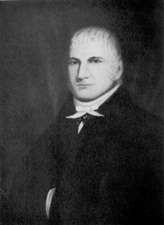David L. Morril
| David Lawrence Morril | |
|---|---|
 | |
| United States Senator from New Hampshire | |
|
In office March 4, 1817 – March 3, 1823 | |
| Preceded by | Thomas W. Thompson |
| Succeeded by | Samuel Bell |
| 10th Governor of New Hampshire | |
|
In office June 3, 1824 – June 7, 1827 | |
| Preceded by | Levi Woodbury |
| Succeeded by | Benjamin Pierce |
| Speaker of the New Hampshire House of Representatives | |
| Preceded by | George B. Upham |
| Succeeded by | Henry B. Chase |
| Member of the New Hampshire House of Representatives | |
|
In office 1808–1816 | |
| Personal details | |
| Born |
June 10, 1772 Epping, New Hampshire |
| Died |
January 28, 1849 (aged 76) Concord, New Hampshire |
| Political party | Democratic-Republican |
| Spouse(s) | Lydia Poor, m. 1824 |
| Alma mater |
Dartmouth College University of Vermont (J.D.) |
| Religion | Presbyterian |
David Lawrence Morril (June 10, 1772 – January 28, 1849) was an American politician, attorney, physician and minister. He served as a U.S. Senator for New Hampshire from 1817 to 1823, and was elected as governor of the state, serving from 1824 until 1827.
Early life
Morril was born to Samuel and Anna (Lawrence) Morril in Epping, New Hampshire on June 10, 1772.[1] He graduated from Dartmouth College and later received his law degree from the University of Vermont.
He worked as a clergyman, called to the Congregational Presbyterian Church in 1802 in Goffstown, New Hampshire, where he served for years.[2]
Political career
In 1808, Morril was elected as a member of the New Hampshire House of Representatives; he served until 1816.[3] In his last term in 1816, he was elected by the House as Speaker.[4]
The legislature elected him as the U.S. Senator from New Hampshire in 1817, and he served until 1823.
In 1824 Morril was elected as Governor of New Hampshire, serving from June 3, 1824 to June 7, 1827. In the 1824 election, Morril received the most votes; however, because he failed to win a majority of the votes cast, the election had to be decided by the legislature. Morril was elected by a vote of 163 to 43 during a joint meeting of the New Hampshire legislature.[3] In the 1825 election, Morril ran unopposed; in the 1826 election, Morril defeated his opponent Benjamin Pierce by 5,392 votes. In the 1827 election, Morril was defeated by Pierce by an overwhelming margin: Benjamin Pierce won 21,166 votes out of 27,411 cast.[5]
Personal life
Morril married Lydia Poor in 1824 and they had four children together.
He is buried in the Old North Cemetery, Concord, New Hampshire, near the grave of President Franklin Pierce.
Notes
- ↑ Kelly, Howard Atwood (1920), A Cyclopedia of American Medical Biography:Comprising the Lives of Eminent Deceased Physicians and Surgeons from 1610 to 1910, Baltimore, Maryland: The Norman, Remington Company, p. 818.
- ↑ Coolidge, Austin Jacobs; Mansfield, John Brainard (1859), A History and Description of New England, General and Local, Boston: A.J. Coolidge, pp. 502–504
- 1 2 Kelly, Howard Atwood (1920), A Cyclopedia of American Medical Biography:Comprising the Lives of Eminent Deceased Physicians and Surgeons from 1610 to 1910, Baltimore, Maryland: The Norman, Remington Company, p. 819.
- ↑ Jenks, George E. (1866), Political Journal for the State of The New Hampshire 1867, Concord, New Hampshire: McFarland and Jenks, p. 45
- ↑ Jenks, George E. (1868), Political Manual and Annual Register for the State of New Hampshire For the Political year 1869-1870, Concord, New Hampshire: McFarland and Jenks, p. 60.
External links
| United States Senate | ||
|---|---|---|
| Preceded by Thomas W. Thompson |
U.S. Senator (Class 2) from New Hampshire 1817–1823 Served alongside: Jeremiah Mason, Clement Storer, John F. Parrott |
Succeeded by Samuel Bell |
| Political offices | ||
| Preceded by Levi Woodbury |
Governor of New Hampshire 1824–1827 |
Succeeded by Benjamin Pierce |
| Preceded by George B. Upham |
Speaker of the New Hampshire House of Representatives 1816–1816 |
Succeeded by Henry B. Chase |

